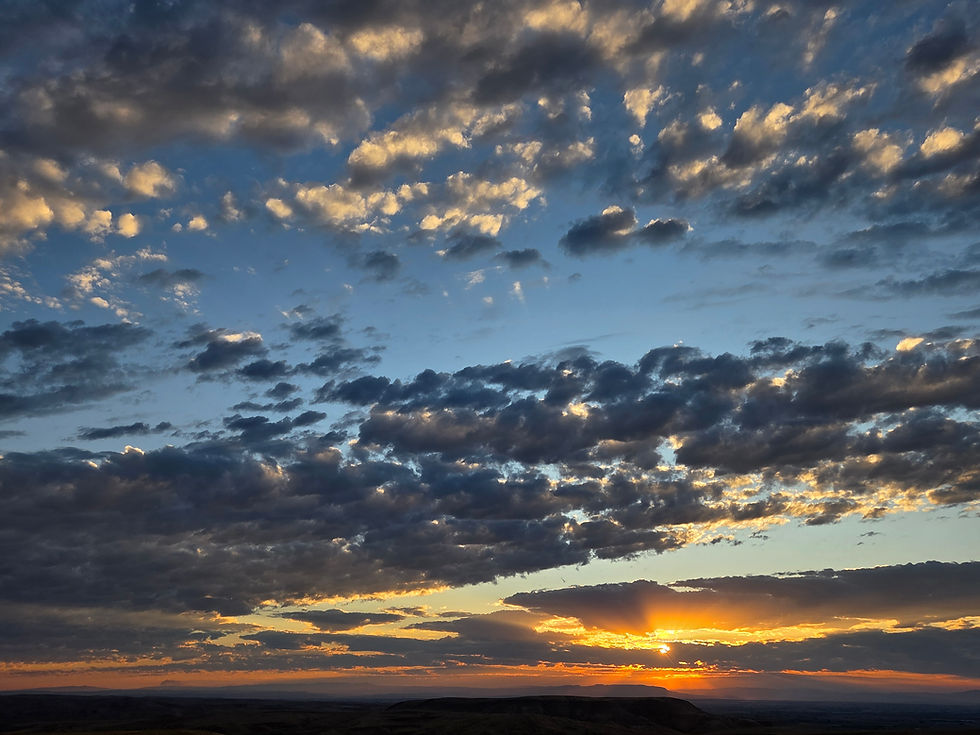OUR MEMORABLE HIKE THROUGH PAINTED CANYON
- MJ Winter - Community Organizer

- Jun 12
- 4 min read
Hidden in Oregon’s remote and rugged Owyhee Canyonlands, the Painted Canyon area offers a jaw-dropping hiking experience for those seeking solitude, natural beauty, and a deeper connection to the land.

I have always wanted to hike this place. I even own gorgeous prints of the area that I’ve displayed in my home for years, always with the intent to finally get a chance to experience it in person: a unique, breathtaking geologic wonderland that features towering three-hundred-foot canyon walls, spires, and natural amphitheaters showcasing a vivid array of colors—reds, purples, golds, and greens. It’s a masterpiece of rock and soil painted by nature itself… no wonder it’s been on my bucket list for years!

A few months ago, I, along with other Friends of the Owyhee, finally set out on the 8.5-mile Carlton Canyon-Painted Canyon Loop. All of us were over 60, in fairly fit condition, yet we were decidedly challenged by this advanced hike. Even reaching the trailhead requires navigating very rough, remote roads that require high-clearance, four-wheel-drive vehicles. But that bumpy drive was worth it to me: this area is known as one of the most beautiful in the Owyhee Canyonlands region has to offer.
Once we arrived at the unmarked “trailhead” and parked near a huge cattle trough, we started a gentle descent down Carlton Canyon. The landscape changed from a slight downward draw to a deeper cow trail amidst a sandy wash lined with large sage. My hiking partners chatted amiably as we hiked downward, but once we caught our first glimpse of the canyons below, we gaped in awe at the sight of them splashed in rich tones of russet, tuff, green, and gold in the morning sunshine.
The Loop we were hiking is in the Honeycomb Wilderness Study Area (WSA), which includes 39,000 acres of BLM land. It’s also an Area of Critical Environmental Concern (ACEC). The topography in the WSA, according to the BLM, is “rugged with a thick deposit of volcanic tuff cut by numerous intermittent streams, resulting in a broken surface of ridges, hills, and drainages, with frequent outcrops and pinnacles”. They certainly got that right; as the land beneath our feet became a bit of an obstacle course of rocks interspersed with grassy, sandy areas that might have been streambeds earlier in the year. We had to carefully plan our footfalls to avoid a twisted ankle in this rough, wild country.

Old-growth sagebrush, some towering over twelve feet tall, dot this landscape; a testament to the resilience of this fragile desert ecosystem. My plant-loving fellow hiker, Siri, told me that in the spring, Painted Canyon comes alive with vibrant wildflowers such as desert globemallow, evening primrose, and penstemon, adding bursts of color to the already stunning palette of the rocks towering above. Even as we hiked in the fall, she pointed out remarkably hardy wildflowers still bearing blue and pink flags in the increasing chill of late October. We hiked on in respectful silence; all of us keeping our eyes peeled for glimpses of mule deer, golden eagles, and pronghorn moving quietly through the landscape.
We stopped to sit on a rock and have a bite to eat near the area where Carlton ends and Painted Canyon begins. Already, the formations were taking my breath away; so magnificent, I can hardly describe them. Shapes and colors flowed everywhere in the rocks above me, and every move we made echoed up both the canyon from which we came and into the one at which we gazed. It was a place that demands your respect and makes you whisper as if in the presence of many watchful eyes. I rather rebelliously named one formation “The Singers” as the turf was shot through with holes and tortuous cones that seemed to mouth some long-ago solemn desert chant.

We progressed now up the canyon, stopping every few steps to take photos. We were around the 6-mile mark when I noticed my knee was starting to complain, and at that point, the bouldering began. We scrambled up several van-sized rocks strewn through draws that required a bit of “pondering and puckering,” as I like to say. Thankfully, we managed due to several hardy members of our group trying different routes and conferring on the best way up. Everyone was helpful and supportive as we moved slowly through the rubble-filled washes and scooched our way across iffy-looking cow trails higher up the hillside than I preferred. Finally, we made it out, exhilarated, panting, victorious, with our goal reached! It was at the point I realized I’d lost my phone, but that’s another tale to tell, in another story…
Near the end, we found a few beer cans scattered in the sage. Hiking in Painted Canyon isn’t just an adventure; it’s a responsibility. This is a remote, pristine area where conservation principles are key: people need to plan carefully by bringing plenty of water, bringing a satellite communication device, packing out all waste, and minimizing their impact on the delicate ecosystem. Hikers/campers should take their time to appreciate the ancient geology and biodiversity that make the Honeycombs area a treasure worth protecting.

If you go, expect to spend 5-6 hours on this unforgettable loop (and at least 90 90-minute drive, each way, to the area where we parked). It’s a hike that will challenge your endurance and inspire awe, leaving you with a renewed sense of respect for the wild places that define the Owyhee Canyonlands.
-MJ Winter, Community Organizer at Friends of the Owyhee





Comments